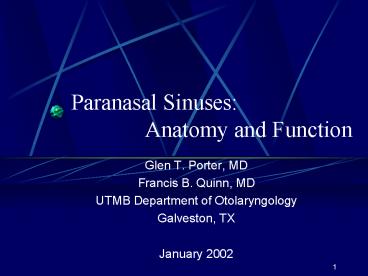Paranasal Sinuses: Anatomy and Function - PowerPoint PPT Presentation
1 / 49
Title:
Paranasal Sinuses: Anatomy and Function
Description:
Paranasal Sinuses: Anatomy and Function Glen T. Porter, MD Francis B. Quinn, MD UTMB Department of Otolaryngology Galveston, TX January 2002 – PowerPoint PPT presentation
Number of Views:848
Avg rating:3.0/5.0
Title: Paranasal Sinuses: Anatomy and Function
1
Paranasal Sinuses Anatomy and Function
- Glen T. Porter, MD
- Francis B. Quinn, MD
- UTMB Department of Otolaryngology
- Galveston, TX
- January 2002
2
Case Report1000B.C.
3
Sinus Anatomy Overview
7 bones 4 paired sinuses 4 turbinates 3
meati Drainage system Nervous supply Vascular
supply Related structures
4
Embryology
Maxilloturbinal Ethmoturbinal Middle turbinate
Superior turbinate Supreme turbinate Agger
nasi Uncinate process Ethmoid infundibulum Sinuses
Maxillary Ethmoid
5
Sinus Development
6
Pediatric Sinuses
7
Bony Structure
Ethmoid Maxilla Palatine Lacrimal Pterygoid plate
of Sphenoid Nasal Inferior Turbinate
8
Arterial Supply
External Carotid Maxillary A.
Sphenopalatine Internal Carotid Ophthalmic A.
Ant. Ethmoid Post. Ethmoid
Supraorbital Supratrochlear
9
Innervation
10
Neurovascular Supply
11
Sinus Drainage Schema
12
Ethmoid Sinus
- Development
- Present at birth
- Anterior/Posterior
- Variability
- Structure
- Volume/shape
- Roof
- Lateral wall
13
Ethmoid Roof
- Anterior 2/3
- Posterior 1/3
- Keros I
- Keros II
- Keros III
14
Ethmoid Cells
Supraorbital, Frontal Bulla, Concha Bullosa,
Hallers, Onodi Cells
15
Ethmoid SinusRelated Structures
- Basal Lamella of the Middle Turbinate
- Three planes
- Agger nasi cell
- Childhood sinus
- Ethmoid Bulla
- Hiatus Semiluninaris/Superior Hiatus Semilunaris
- Suprabullar/retrobullar recesses (Sinus
Lateralis) - Ethmoid Infundibulum/Uncinate Process
- Anterior/Posterior Ethmoid Arteries
- Osteomeatal complex
16
Basal/Ground Lamella
Basal/Ground Lamella Of the Middle Turbinate
17
The Agger Nasi Cell
18
Ethmoid Bulla Uncinate Process Hiatus
Semilunaris
19
Ethmoid Infundibulum
20
Suprabullar/Retrobullar Recess
21
Ethmoid Arteries
22
Osteomeatal Complex Middle meatus Maxillary
Sinus Ostium Anterior Ethmoid Drainage
23
Maxillary Sinus
- Development
- Present at birth
- Biphasic growth
- Level of the floor
- Structure
- Volume shape
- Walls, floor, roof
24
Maxillary Sinus
25
Maxillary Sinus
26
Maxillary Sinus
- Related Structures
- Fontanelles
- Natural ostium
- Hallers Cells Sinusitis
- Osteomeatal complex
- Accessory Ostium
- Nasolacrimal duct
27
Fontanelles
28
Natural Ostium -Hallers cells Accessory
Ostium
29
Nasolacrimal Duct
30
Frontal Sinus
- Development
- Frontal bone at birth
- Age 5
- Structure
- Volume and shape
- Ostium
- Walls
- Anterior vs. posterior
- Related Structures
- Frontal recess
31
Frontal Sinus
Ostium Frontal recess Boundaries Dumbbell
shape Sinus Lateralis Frontal Bulla
32
Sphenoidal Sinus
- Development
- Arise within the nasal capsule (no pouch)
- Age 3 begins to pneumatize
- Structure
- Volume/variable pneumatization
- Wall thickness
- Position within the sphenoid
- Relation to sella turcica
- Sellar and postsellar relationships
33
Sphenoid Sinus Pneumatization
34
Sphenoid Sinus
Sphenoid Sinus
35
Sphenoid Sinus
36
Sphenoid Sinus
- Ostium
- Size (.5-4mm)
- Location (sinus floor, anterior nasal floor,
anterior sinus wall, superior turbinate,
cribiform plate) - Bony dehiscence
- Related Structures
- Sphenoethmoidal recess
- Sphenoid rostrum
- Onodi cell
37
Sphenoid Ostium Sphenoethmoid Recess Sphenoid
Rostrum
38
The Onodi Cell
39
Microscopic Anatomy
- Mucosa
- Cilliated columnar epithelial cells
- Anatomy
- Beat frequency
- Inhibitory effects of contact
- Noncilliated columnar cells
- Distribution
- Function
- Basal cells
40
Microscopic AnatomyContd
- Goblet Cells
- Glycoproteinsviscosity and elasticity
- Innervation (parathick, sympthin)
- Basement membrane
- Submucosal glands
- Distribution
41
Microscopic Anatomy
42
Mucous Blanket
- Two layers
- Superficial layer
- Sol layer
- Function
- Superficial layer traps bacteria and particulate
matter. - Enzymes, antibodies, immune cells
43
Mucociliary Transport
- Directional Flow of Mucous
- Toward the choanae
- Ostium drainagea stubborn beast
- Hilding, MD
- Contact inhibition
- Hallers cells
- Surgery
44
Mucociliary Transport
45
Function of Paranasal Sinuses
- Humidifying and warming inspired air
- Regulation of intranasal pressure
- Increasing surface area for olfaction
- Lightening the skull
- Resonance
- Absorbing shock
- Contribute to facial growth
46
New Frontiers
- Sleep apnea and the sinuses
- Humidification contributes up to 6.9mm Hg serum
pO2 - Mouth breathers noted to have decreased end-tital
CO2increased serum CO2apneas (high baseline) - Nitric Oxide (NO)
- NO produced primarily in sinuses
- Toxic to bacteria, fungi, viruses
- Increases cilliary motility
47
Case Report
- 39 yom with h/o sinus disease c/o headache,
rhinorrhea. - PMHx of sinus surgery years ago
- ROS reveals h/o two episodes of meningitis in
past few years - PE right superior nasal mass. S/p FESS. Clear
rhinorrhea.
48
(No Transcript)
49
References
- Anon, Jack B., et al, Anatomy of the Paranasal
Sinuses, Theime, New York, c1996. - Bhatt, Nikhil J., Endoscopic Sinus Surgery
New Horizons, Singular Publishing Group, Inc.,
San Diego, c1997. - Bailey, Byron J., et al, Head Neck Surgery
-- Otolaryngology, Lippincott Williams Wilkins,
Philadelphia, c2001. - Lundberg, J., Weitzberg, E. Nasal Nitric
Oxide in Man. Thorax 1999 54(10)947-952. - McCaffrey, Thomas V., Rhinologic Diagnosis
and Treatment, Thieme, New York, c1997. - Marks, Steven C. Nasal and Sinus Surgery,
W.B. Saunders Co., Philadelphia, c2000. - Navarro, Joao A.C., The Nasal Cavity and
Paranasal Sinuses, Springer, Berlin, c2001. - Watelet, J.B., Cauwenberge P. Van, Applied
Anatomy and Physiology of the Nose and Paranasal
Sinuses. Allergy 1999 54, Supp 5714-25.































